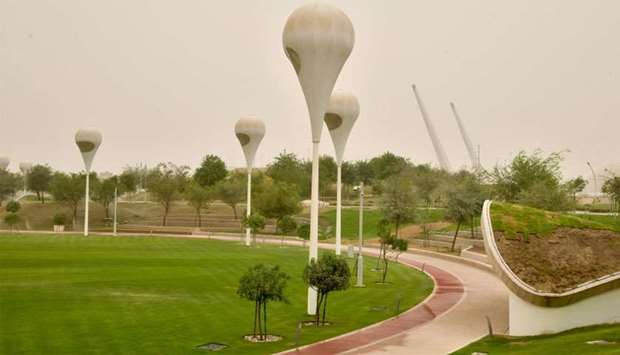Qatar Green Building Council ( QGBC) has highlighted that the Education City of Qatar Foundation (QF) is setting an excellent example of how sustainability and green building practice can transform space for natural and human well-being.
QGBC points out that it is done in the Education City through five aspects of green design namely: Air and Space; Transport; Lifestyle; Vegetation as well as Design and Architecture.
There are many open spaces in Education City, but none as unique as Oxygen Park, an impressive 130,000sq m green space created near the Hamad Bin Khalifa University Student Centre.
Oxygen Park is designed as a shade-rich, green lung in the campus, providing a contrast to daily routine of academic and professional life and showcasing the possibilities inherent in native and adaptive planting and water-efficiency.
Its sculptured gardens contain more than a hundred plant species including natives such as Arabic Gum, Ghaf, Samar, Salam, and Sidra trees.
The West Green Spine in Education City offers a 54,000sq m space incorporating a sport and recreation area for basketball, volleyball, and football, along with an area for relaxation, fitness, and family enjoyment.
Education City is also developing a world-first golf club designed to promote a relaxed, inclusive, family approach to fitness and the enjoyment of the outdoors.
By incorporating a championship 18-hole course along with a nine-hole and a unique six-hole championship course, these spaces in principle welcome people with different interests and skills to a novel experience while enhancing their health and physical fitness and enjoying the natural environment.
Qatar Foundation plans for cars to be drastically reduced within the entire Education City campus in the near future.
To transport students, staff and visitors around Education City, a state-of-the art 11.5km tramway is being built.
Nineteen trams, specially designed for Qatar’s hot environment, will run along it, each 27m long in three sections.
The trams will incorporate heavy-duty air-conditioning systems and special sun shades on the roof to protect against the high temperatures Until the tramway opens, students have the option to cycle or walk through safe spaces between buildings, allowing them to enjoy the open air during temperate weather.
To encourage good lifestyle and health decisions as part of community engagement, Education City hosts a weekly market offering organic and locally-grown food and homemade products.
The market resulted from a partnership between QF, Qua’ranic Botanic Garden and Torba Farmers Market – a Qatar-based, community-inspired initiative which aims to help create healthier, more active communities and support local products and agriculture.
Similarly, Chef’s Garden in Education City is becoming well-known as one of the very few organic restaurants in Qatar.
All its delicious meals are not only exquisitely presented but also made with nutritious, local ingredients sourced directly from organic farms in Qatar for the majority of the vegetables, lamb and chicken served.
Education City as a whole is being developed for use by its visitors for recreation and sports as a break from the working day or as a destination for city residents and tourists.
One of its key recreational features include 7km of pathways, a covered walkway, a 1,600m running track, an equestrian track, and sports pitches, as well as the tranquil expanses of Oxygen Park and the golf course.
Oxygen Park contains many species of plants native to Qatar and the region as well as heat- and drought-tolerant species from further afield.
Numerous studies have shown that enjoyable time spent outdoors in nature can contribute to lowered stress levels and a sense of well-being that contributes to both mental and physical good health.
Of particular interest is the Qur’anic Botanic Garden, which exhibits botanical specimens of those plant species mentioned in the Holy Qur’an, Hadith and Sonna.
The Garden educates visitors on the significance of the plants’ appearances in holy scripture, as well as providing scientific explanations of their characteristics, applications and usefulness to man.
Species on display include the Sidra tree, the iconic natural symbol of Qatar’s heritage.
As Her Highness Sheikha Moza bint Nasser, chairperson, Qatar Foundation, noted at the inauguration of Education City on October 13, 2003, the Sidra is an emblem of aspiration: its strong form reaching from earth towards the sky ‘reminds us that goals of this world are not incompatible with the goals of the spirit.’
The shaping of space for human use carries great responsibility.
QGBC is Qatar’s institution for the provision and implementation of green standards, best practice and sustainability-oriented outreach programmes towards Qatar National Vision 2030 goals.
QGBC works closely with QF management and a wide range of stakeholders to support the adoption, legislation and implementation of green building practice and standards by incentivising and rewarding such efforts.
At the same time QGBC encourages greener procurement practices by making databases of green-oriented companies available.
Internationally recognised certifications and rating systems for sustainability such as LEED (Leadership in Energy and Environmental Design), WELL building Standard and Green Key are among the tools promoted by QGBC for building projects throughout Qatar.
These enhance the sustainability and efficiency of buildings across many criteria: materials, energy demand, water use, comfort and other features.
The first QF campus building to earn a LEED certification, at Gold level, was the Qatar National Convention Centre Extension/Exhibition Hall in 2012.
Northwestern University in Qatar was latest awarded Gold LEED certification for its new building, which also won the ‘Green Educational Building’ category in the Qatar Sustainability Awards 2016.
LEED Platinum certification was awarded in 2013 to twelve buildings – the largest group to be awarded Platinum in the world at till date – of Education City’s environmentally friendly student housing for Hamad Bin Khalifa University, featuring power from renewable sources and monitoring units to allow students to track their own energy and water.
Education City’s ongoing evolution into a destination for recreation, knowledge, and well-being shows the way towards a greener and more sustainable Qatar and demonstrates the practical realisation of sustainability principles to improve the day-to-day life of real communities.
It is an example for cities worldwide to watch.



